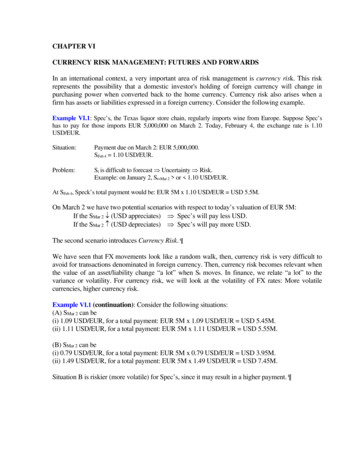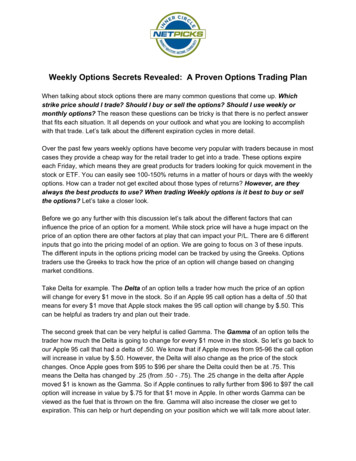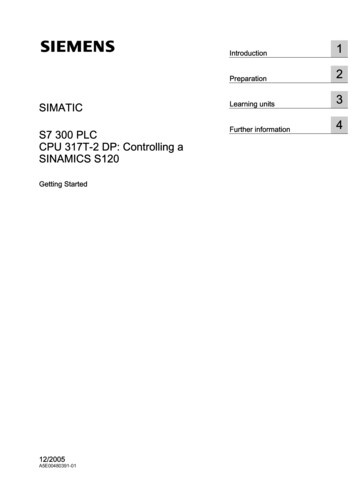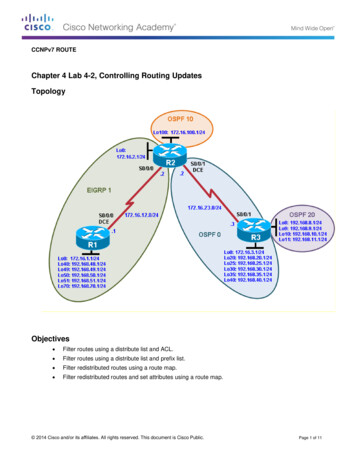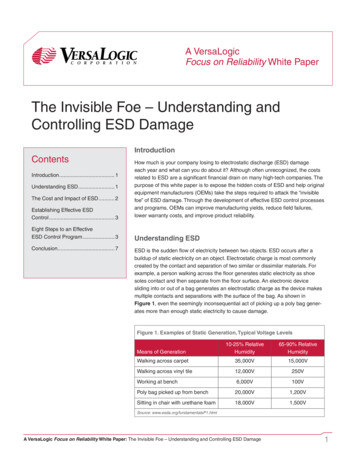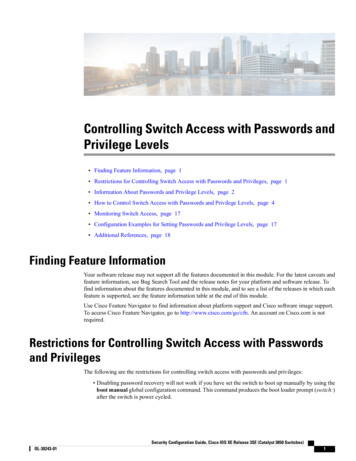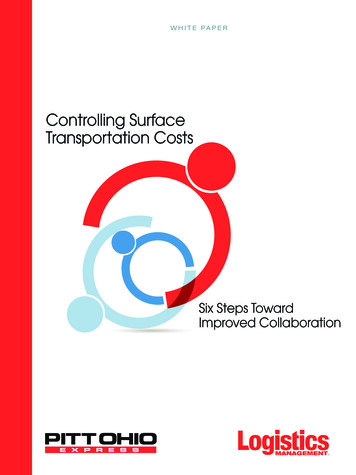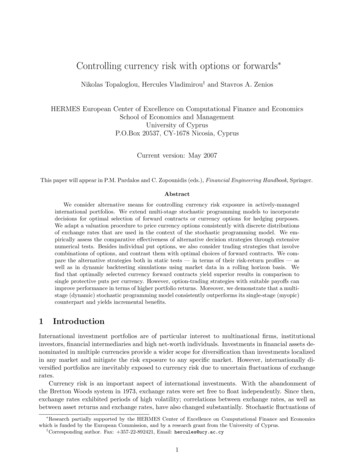
Transcription
Controlling currency risk with options or forwards Nikolas Topaloglou, Hercules Vladimirou† and Stavros A. ZeniosHERMES European Center of Excellence on Computational Finance and EconomicsSchool of Economics and ManagementUniversity of CyprusP.O.Box 20537, CY-1678 Nicosia, CyprusCurrent version: May 2007This paper will appear in P.M. Pardalos and C. Zopounidis (eds.), Financial Engineering Handbook, Springer.AbstractWe consider alternative means for controlling currency risk exposure in actively-managedinternational portfolios. We extend multi-stage stochastic programming models to incorporatedecisions for optimal selection of forward contracts or currency options for hedging purposes.We adapt a valuation procedure to price currency options consistently with discrete distributionsof exchange rates that are used in the context of the stochastic programming model. We empirically assess the comparative effectiveness of alternative decision strategies through extensivenumerical tests. Besides individual put options, we also consider trading strategies that involvecombinations of options, and contrast them with optimal choices of forward contracts. We compare the alternative strategies both in static tests — in terms of their risk-return profiles — aswell as in dynamic backtesting simulations using market data in a rolling horizon basis. Wefind that optimally selected currency forward contracts yield superior results in comparison tosingle protective puts per currency. However, option-trading strategies with suitable payoffs canimprove performance in terms of higher portfolio returns. Moreover, we demonstrate that a multistage (dynamic) stochastic programming model consistently outperforms its single-stage (myopic)counterpart and yields incremental benefits.1IntroductionInternational investment portfolios are of particular interest to multinational firms, institutionalinvestors, financial intermediaries and high net-worth individuals. Investments in financial assets denominated in multiple currencies provide a wider scope for diversification than investments localizedin any market and mitigate the risk exposure to any specific market. However, internationally diversified portfolios are inevitably exposed to currency risk due to uncertain fluctuations of exchangerates.Currency risk is an important aspect of international investments. With the abandonment ofthe Bretton Woods system in 1973, exchange rates were set free to float independently. Since then,exchange rates exhibited periods of high volatility; correlations between exchange rates, as well asbetween asset returns and exchange rates, have also changed substantially. Stochastic fluctuations of Research partially supported by the HERMES Center of Excellence on Computational Finance and Economicswhich is funded by the European Commission, and by a research grant from the University of Cyprus.†Corresponding author. Fax: 357-22-892421, Email: hercules@ucy.ac.cy1
exchange rates constitute an important source of risk that needs to be properly considered (see, e.g.,Eun and Resnick [9]). Thus, it is important to investigate the relative effectiveness of alternativemeans for controlling currency risk.Surprisingly, in practice, and usually in the literature as well, international portfolio management problems are addressed in a piecemeal manner. First, an aggregate allocation of funds acrossvarious markets is decided at the strategic level. These allocations are then managed pretty muchindependently, typically by market analysts who select investment securities in each market andmanage their respective portfolio. Performance assessment is usually based on comparisons againstpreselected benchmarks. Currency hedging is often viewed as a subordinate decision; it is usuallytaken last so as to cover exposures of foreign investments that were decided previously. Changesin the overall portfolio composition are not always coordinated with corresponding adjustments tothe currency hedging positions. Important and interrelated decisions are considered separately andsequentially. This approach neglects possible cross-hedging effects among portfolio positions andcannot produce a portfolio that jointly coordinates asset and currency holdings so as to yield an optimal risk-return profile. Jorion [15] criticized this overlay approach; he showed that it is suboptimalto a holistic view that considers all the interrelated decisions in a unified manner.We consider models that jointly address the international diversification, asset selection, andthe currency hedging decisions. An important part of this study is the comparison of alternativeinstruments and tactics for controlling currency risk in international financial portfolios. In dynamicportfolio management settings this is a challenging problem. We employ the stochastic programmingparadigm to empirically assess the relative performance of alternative strategies that use eithercurrency forward contracts or currency options as means of controlling currency risk.A currency forward contract constitutes an obligation to sell (or buy) a certain amount of aforeign currency at a specific future date, at a predetermined exchange rate. A forward contracteliminates the downside risk for the amount of the transaction, but at the same time it forgoes theupside potential in the event of a favorable movement in the exchange rate. By contrast, a currencyput option provides insurance against downside risk, while retaining upside potential as the optionis simply not exercised if the exchange rate appreciates. So, currency forward contracts can beconsidered as more rigid hedge tools in comparison to currency options.Few empirical studies on the use of currency options are reported in the literature. Eun andResnick [10] examine the use of forward contracts and protective put options for handling currencyrisk. In ex ante tests, they find that forward contracts generally provide better performance inhedging currency risk than single protective put options. Albuquerque [3] analyzes hedging tacticsand shows that forward contracts dominate the use of single put options as hedges of transactionexposures. The reason is that forward contracts pay more than single options on the downside, henceless currency needs to be sold forward to achieve the same degree of hedging; a smaller hedge ratiois required and the cost for hedging is less. Maurer and Valiani [21] compare the effectiveness ofcurrency options versus forward contracts for hedging currency risk. They find that both ex-post,as well as in out-of-sample tests, forwards contracts dominate the use of single currency put options.Only put in-the-money options produce comparable results with optimally-hedged portfolios withforwards. Their results indicate more active use of put in-the-money options than at-the-moneyor out-of-the money put options which reveals the dependence of a hedging strategy based on putoptions on the level of the strike price.Conover and Dubofsky [6] consider American options. They empirically examine portfolio insurance strategies employing currency spot and future options. They find that protective puts usingfuture options are generally dominated by both protective puts that use options on spot currenciesand by fiduciary calls on futures contracts. Lien and Tse [18] compare the hedging effectiveness ofcurrency options versus futures on the basis of lower partial moments (LPM). They conclude thatcurrency futures provide a better hedging instrument than currency options; the only situation in2
which options outperform futures occurs when the decision maker is optimistic (with a large targetreturn) and not too concerned about large losses.Steil [25] applies an expected utility analysis to determine optimal contingent claims for hedging foreign transaction exposure as well as optimal forward and option hedge alternatives. Usingquadratic, negative exponential and positive exponential utility functions, Steil concludes that currency options play limited useful role in hedging contingent foreign exchange transaction exposures.There is no consensus in the literature regarding a universally preferable strategy to hedge currency risk, although the majority of results indicate that currency forwards generally yield betterperformance than single protective put options. Earlier studies do not jointly consider the optimalselection of internationally diversified portfolios. Our study addresses this aspect of the portfoliomanagement problem in connection with the associated problem of controlling currency risk, andcontributes to the aforementioned debate. We empirically examine whether forward contracts areeffective hedging instruments, or whether superior performance can be achieved by using currencyoptions — either individual protective puts or combinations of options with appropriate payoffs.To this end, we extend the multistage stochastic programming model for international portfoliomanagement that was developed in Topaloglou et al. [27] by introducing positions in currency options to the decision set at each stage. The model accounts for the effects of portfolio (re)structuringdecisions over multiple periods, including positions in currency options among its permissible decisions. The incorporation of currency options in a practical portfolio optimization model is a noveldevelopment. A number of issues are addressed in the adaptation of the model. Currency optionsare suitably priced at each decision stage of the stochastic program in a manner consistent with thescenario set of exchange rates. The scenario-contingent portfolio rebalancing decisions account forthe discretionary exercise of expiring options at each decision point.The dynamic nature of portfolio management problems motivated our development of flexiblemulti-stage stochastic programming models that capture in a holistic manner the interrelated decisions faced in international portfolio management. Multi-stage models help decision makers adoptmore effective decisions; their decisions consider longer-term potential benefits and avoid myopicreactions to short-term movements that may lead to losses.We use the stochastic programming model as a testbed to empirically assess the relative effectiveness of currency options and forward contracts to control the currency risk of internationalportfolios in a dynamic setting. We analyze the effect of alternative strategies on the performanceof international portfolios of stock and bond indices in backtesting experiments over multiple timeperiods. Our empirical results confirm that portfolios with optimally-selected forward contractsoutperform those that involve a single protective put option per currency. However, we find thattrading strategies involving suitable combinations of currency options have the potential to producebetter performance. Moreover, we demonstrate through extensive numerical tests the viability of amulti-stage stochastic programming model as a decision support tool for international portfolio management. We show that the dynamic (multi-stage) model consistently outperforms its single-stage(myopic) counterpart.The paper is organized as follows. In section 2 we present the formulation of the optimizationmodels for international portfolio selection. In section 3 we discuss the hedging strategies employedin the empirical tests. In section 4 we describe the computational tests and we discuss the empiricalresults. Section 5 concludes. Finally, in the Appendix we describe the procedure for pricing Europeancurrency options consistently with the discrete distribution of exchange rates on a scenario tree.2The International Portfolio Management ModelThe international portfolio management model aims to determine the optimal portfolio that has theminimum shortfall risk at each level of expected return over the planning horizon. The problem is3
viewed from the perspective of a US investor who may hold assets denominated in multiple currencies.The portfolio is exposed to market and currency risk. To cope with the market risk, the portfolio isdiversified across multiple markets. International diversification exposes the foreign investments tocurrency risk. To control the currency risk, the investor may enter into currency exchange contractsin the forward market, or buy currency options — either single protective puts, or combinations ofoptions that form a particular trading strategy.In this section we develop scenario-based stochastic programming models for managing investment portfolios of international stock and government bond indices. The models address the problemsof optimal portfolio selection and currency risk management in an integrated manner. Their deterministic inputs are: the initial asset holdings, the current prices of the stock and bond indices, thecurrent spot exchange rates, the forward exchange rates or the currency option prices — dependingon which instruments are used to control currency risk — for a term equal to the decision interval. We also specify scenario-dependent data, together with associated probabilities, that representthe discrete process of the random variables at any decision stage in terms of a scenario tree. Theprices of the indices and the exchange rates at any node of the scenario tree are generated with themoment-matching procedure of Høyland et al. [11]; these, in turn, uniquely determine the optionpayoffs at any node of the tree.We explore single-stage, as well as multi-stage stochastic programming models to manage international portfolios of financial assets. The multi-stage model determines a sequence of buying andselling decisions at discrete points in time (monthly intervals). The portfolio manager starts with agiven portfolio and with a set of postulated scenarios about future states of the economy representedin terms of a scenario tree, as well as corresponding forward exchange rates or currency option pricesdepended on the postulated scenarios. This in
currency options versus futures on the basis of lower partial moments (LPM). They conclude that currency futures provide a better hedging instrument than currency options; the only situation in 2. which options outperform futures occurs when the decision maker is optimistic (with a large target return) and not too concerned about large losses. Steil [25] applies an expected utility analysis to .

